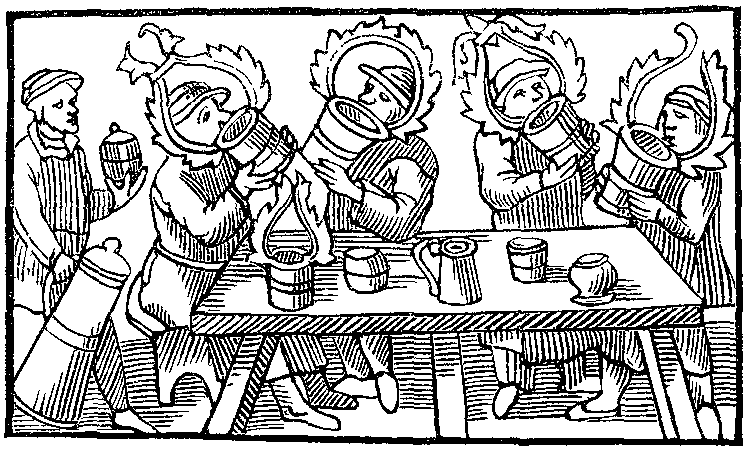Olde School Gaming, Mydwandr

Image by Olaus Magnus
Playing games in an Olde School way
I recently discovered that Olde House Rules had released a new book. This reminded me that I love their rules. The publishing duo consists of James and Robyn George. A couple who, according to their website have been playing together since 2002, though James admittedly has been playing since the 70s. Their goal is to create games that fit how they want to play. This is very good news because the games they create are also pretty close to how I want to play.
Pits and Perils was created as a game that harkened back to the original games created so many years ago. They continued and created Barons of Braunstein to recreate the feeling of playing in a game of Braunstein. I could continue listing off all of their wonderful games, most of which I have at least read, but that is not my goal here. PDFs of their games can be found on DrivethruRPG here. Picking up any individual book will not run up your bill much as for the most part they are less than $5 a pop. I would also just quickly like to recommend Diceless Dungeons which is exactly what it sounds like, a ruleset to play RPGs without needing dice.
The real focus of this post is to highlight Mydwandr, available from Drivethru as PDF and Lulu as a hardcover offering, the newest offering from the creators.
This is simple gaming at its finest. James and Robyn have created a rule system they have simply referred to as one rule to rule them all (chef’s kiss, what a brilliant name!), but not only is the game a light and elegant rules system, it also doubles as a pretty kickass setting.
The One Rule to Rule Them All
The system uses a d6 resolution, calling for a single, double or triple roll for anything. Rolling a double is a roll with 2d6 and a triple allows for three dice to be rolled choosing the better two. The target number for any roll is 8 or more. A triple is rewarded when the situation is in favor of the players or they have relevant abilities to allow for an advantage as outlined by the rules.
Character Creation
Character creation is quick and easy. Choose your kinship Dwarf, Elf or Human, I would of course recommend adding halflings since I need them in my elf games, each having their advantage in play.
The Setting
The setting is a fun world that is reminiscent of Middle Earth if there was slightly more Northern European influence in Tolkein’s work.
In this world there are dwarves, elves and humans. The dangers listed in the book include creatures like bears, crocodiles, demons, dragur, giants, hags, trolls, urku and wyrms. All of these come with a paragraph or so description which gives the basic information you would want for them as being in the world, then a short stat block that gives any and all vital information for combating or whatever your adventurers need to interact with them while in the world.
A few of these, like horses, aren’t especially dangerous, but are included because they represent what the setting (storied Mydwandr or otherwise) has to offer.
Mydwandr, pg. 20 on hazards…
Tables for use in gaining rewards are available and mimic what one would expect in a low (is limited maybe a better word here?) magic fantasy world. The tables will be familiar in feeling if you have read through the treasure tables from OSE or other B/X clones. Similar in feel not necessarily borrowed. Most of these tables use a double roll., though as a referee I could easily see using triples in certain situations where you might want to be able to skew the results to a higher degree. A seven page primer on a version of the world is offered at the end of the book. This includes three maps (same map just different information on each) and gives just enough information to allow a referee the freedom to explore, expand and expound upon the world. The advice in this book is short and concise, giving just enough for a seasoned referee the seeds to run with the game and allowing for a newer referee to gather enough information to run a game.
-Horse. These include mules, ponies, and warhorses, with hits assigned accordingly. Properly outfitted, each may transport 25 additional items and 10,000 coins in saddlebags. AS: –/LL: 3/MT: 60’/TE: —
Mydwandr, Pg. 25 that horse stat block…
Final Thoughts
Overall the only complaint I have about the game is the one little section labeled Balance. This says that the referee should strive for balance. It is brief and does not justify, nor indulge the reader with details about this.
Balance
The referee should strive for a balanced game, although sometimes, characters make their own fairness by avoiding those enemies beyond their abilities. Additionally, the referee can adjust numbers and/or hit points to ensure parity.Mydwandr, Pg. 31 on balance…
I would hate to have someone feel required to spend a lot of time making sure that encounters are balanced in a way that feels too prescriptive with things like challenge ratings. Take that as you will.
I will be taking this game to run with a group of my students soon, the idea is to show them how easy a game can be to play and run. It will be part of the series of games I hope to run for my students this year.
Derek Bizier, the Halfling ’seriously, please add me into your book” Master